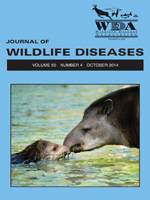From 2011–12, we studied a gopher tortoise (Gopherus polyphemus) population with a historically high prevalence of antibodies to Mycoplasma agassizii to assess long-term effects of upper-respiratory-tract disease (URTD) on tortoise behavior. We radiotracked 30 adult tortoises (16 males, 14 females) from a long-term study site with the use of mark–recapture methods to determine site fidelity and to compare home-range size to that of a study in 1997. An additional 10 tortoises (six males, four females) with severe clinical signs of URTD from elsewhere in the study area were radiotracked and compared to tortoises that were asymptomatic or had only mild clinical signs. We also monitored thermoregulatory behavior of tortoises with the use of data loggers affixed to the carapace. There was no significant difference in home-range size between the asymptomatic tortoises and those with mild symptoms. Home ranges of tortoises with severe URTD were significantly larger than asymptomatic or mildly affected tortoises. Tortoises with severe clinical signs moved long distances over short periods, contradicting a hypothesis that chronically infected tortoises are less likely to emigrate. Prevalence of M. agassizii antibodies was similar among the three groups (98% overall), but prevalence of antibodies to a second pathogen associated with URTD, Mycoplasma testudineum, was lower in the asymptomatic (n = 14, 7%) and mild-symptoms (n = 7, 14%) groups than the severe-symptoms group (n = 8, 50%). Variation in the average carapacial temperatures of tortoises with severe URTD was significantly different from carapacial temperatures of mild and asymptomatic tortoises, suggesting differences in thermoregulatory behavior of severely ill tortoises. Our 15-yr recapture data suggest that, despite high prevalence of M. agassizii, population density has not decreased over time. However, emigration, especially of tortoises with severe clinical disease, may play an important role in dispersal and persistence of pathogens.
How to translate text using browser tools
1 October 2014
EFFECTS OF MYCOPLASMAL UPPER-RESPIRATORY-TRACT DISEASE ON MOVEMENT AND THERMOREGULATORY BEHAVIOR OF GOPHER TORTOISES (GOPHERUS POLYPHEMUS) IN GEORGIA, USA
Jessica L. McGuire,
Lora L. Smith,
Craig Guyer,
Michael J. Yabsley
ACCESS THE FULL ARTICLE

Journal of Wildlife Diseases
Vol. 50 • No. 4
October 2014
Vol. 50 • No. 4
October 2014
behavior
gopher tortoise
Mycoplasma
telemetry
thermoregulation




